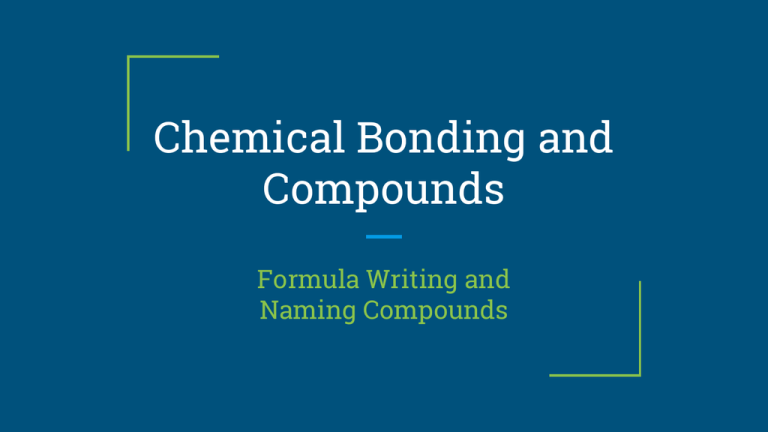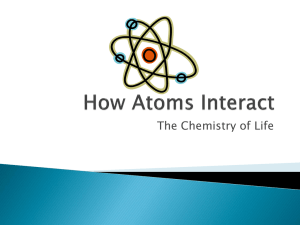Compounds and Chemical Bonds
advertisement

Chemical Bonding and Compounds Formula Writing and Naming Compounds Chemical bond Molecules: two atoms joined together with a chemical bond; can be the same or different types of atoms Compounds: two or more different elements joined together chemically Atoms form compounds and molecules to become stable and fill their outer shell Chemical Formula Tells what elements and the number of atoms of that element that are in a compound or molecule. 2 H2O coefficient the number of units of each substance SO4-2 subscript - the number of atoms of a particular element that are in a molecule superscript oxidation number or the number of electrons gained or lost Ionic vs Covalent Bonding Foldable List three examples of molecules or compounds of each type of bond. Place the following phrases in the appropriate section of the foldable. Transfer of electrons creates oppositely charged ions Electrons are shared between atoms Between 2 nonmetals Between a metal and a nonmetal Chemical Bond Force that holds two atoms together in molecules and compounds Two Types Ionic - attraction formed when atoms transfer electrons to make oppositely charged ions. Between a metal and nonmetal (“I HOP IT is IONIC”) Covalent - bond formed when atoms share electrons. Between a nonmetal and nonmetal Complete the following chart using the word bank below: Force Atoms Chemical Bonds Shared More Stable Nonmetal and Metal Covalent 2 Nonmetals to make them Lost or Gained include two kinds are a that hold together Ionic in which electrons are where attraction is between in which electrons are where attraction is between Writing Formulas Binary Compounds - compound composed of two elements Oxidation numbers - the number of electrons an atom will gain or lose to become an ion. (The number above the group number of the periodic table). Writing Formulas 1. Write the symbol of the element with the positive oxidation number. 2. Write the symbol of the element with the negative oxidation number. 3.Use the criss-cross method with the charge (without the sign) of one ion becoming the subscript of the other ion. Compounds formed Al+3will have O-2a net charge of zero. Al2O3 Practice Write the Formulas between the following two elements 1. Lithium and Bromine 2. Barium and Fluorine 3. Potassium and Iodine 4. Sodium and Nitrogen 5. Magnesium and Fluorine Naming Ionic Compounds 1. Name the metal first. 2. Write the root of the nonmetal (chlorine is chlor-, oxygen is ox-, bromine is brom-) 3. Slap -ide on the backside of the root of the nonmetal. (phosphide, sulfide, fluoride) Ex: NaCl - sodium chloride, MgO - magnesium oxide Naming Covalent Compounds 1. Use prefixes to indicate number of atoms. The prefix mono- (one) is never used for the first element. 2. Slap -ide on the backside of the 2nd nonmetal. Ex: CO2 - carbon dioxide and P2S5 - diphosphorus pentasulfide Name the following binary compounds. Be sure to tell if each is ionic or covalent first, then name accordingly. 1. CaBr2 2. N2F4 3. CS2 4. CO 5. H2O 6. AgCl Polyatomic Ions - charged molecule composed of two or more atoms that act as a single unit. Transition Metals When writing and naming transition metals you must use a roman numeral, which indicates the oxidation number for that transition metal.





